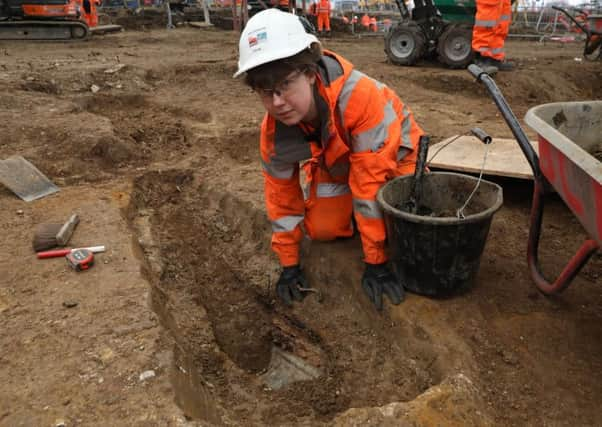‘We were very lucky’ – lost remains of Donington explorer Captain Matthew Flinders discovered as part of HS2 rail project


The team were able to identify his remains through a named lead depositum plate (or breast plate) placed on top of his coffin.
It was in October when archaeologists began excavating the area where Captain Flinders was believed to have been buried.
Advertisement
Hide AdAdvertisement
Hide Ad

The site – St James’s Gardens, a former burial ground next to Euston station in London – is required for the new HS2 terminus station and archaeologists and related specialists are currently preparing the site for construction.
Their work will see the remains of 40,000 people buried at the site being exhumed for re-interment elsewhere.
The discovery of Captain Flinders’ remains so early in the dig is said to have has thrilled archaeologists working on the project.
Commenting on the find ahead of Australia Day tomorrow (January 26), Helen Wass, HS2 head of heritage, said: “The discovery of Captain Matthew Flinders’s remains is an incredible opportunity for us to learn more about the life and remarkable achievements of this British navigator, hydrographer and scientist.
Advertisement
Hide AdAdvertisement
Hide Ad

“Captain Matthew Flinders put Australia on the map due to his tenacity and expertise as a navigator and explorer.
“Given the number of human remains at St. James’s, we weren’t confident that we were going to find him. We were very lucky that Captain Flinders had a breastplate made of lead meaning it would not have corroded. We’ll now be able to study his skeleton to see whether life at sea left its mark and what more we can learn about him.
“This discovery is particularly exciting for me as an archaeologist as Cpt. Matthew Flinders was the grandfather of renowned Sir William Matthew Flinders Petrie, commonly known as the ‘Father of Archaeology’.
“The Flinders name is synonymous with exploration, science and discovery and HS2, through its archaeology programme, will ensure that we maximise the opportunities for further academic and scientific study.”


Cpatain Flinders was buried at the site on July 23, 1814.
Advertisement
Hide AdAdvertisement
Hide AdHe made several significant voyages, most notably as commander of HMS Investigator which he navigated around the entire coast of Australia. This made him the first known person to sail around the country in its entirety.
He is also credited with giving Australia its name, although not the first to use the term, his work popularised its use. His surname is associated with many places in Australia, including Flinders Station in Melbourne, Flinders Ranges in South Australia and the town of Flinders in Victoria.
Following the expansion of Euston station westwards into part of the burial ground in 1840s, Flinders’s headstone was removed and it was thought that is remains had been lost. For a long time, there was an urban myth that Captain Flinders was buried under platform 15.
At the bicentenary of his death in 2014, a memorial statue of Captain Matthew Flinders was unveiled by the Duke of Cambridge at Australia House and later installed at Euston Station. Virgin Trains also named one of its Pendolino trains ‘The Matthew Flinders’.
Advertisement
Hide AdAdvertisement
Hide AdCaptain Flinders will be re-interred with the buried population of St James’s Gardens at a location to be announced.
Commenting on the wider HS2 programme, Mark Thurston, HS2 chief executive said: “How we build HS2 is as important to us as what we are building, which is why we are committed to sharing as much of our cultural heritage as possible.
“The discovery of one of Britain’s most significant explorers helps us tell stories of our past as we prepare to build a high speed rail network that is an important part of our future.
“Before we bore the tunnels, lay the tracks and build the stations, an unprecedented amount of archaeology is now taking place between London and Birmingham. This is the largest archaeological exploration ever in Britain, employing archaeologists and heritage specialists from across the country and beyond, and we’re proud its part of the wider HS2 story.”